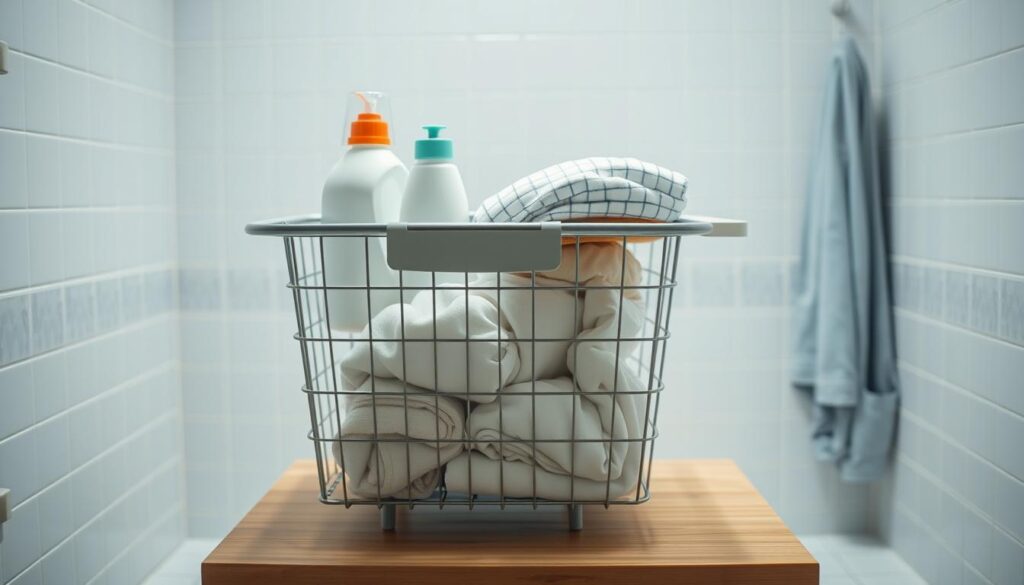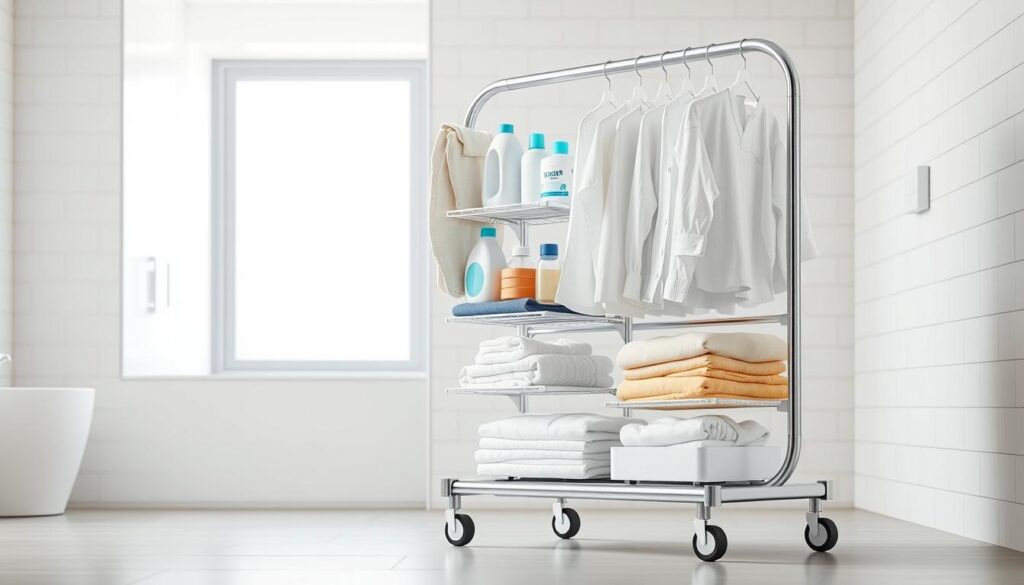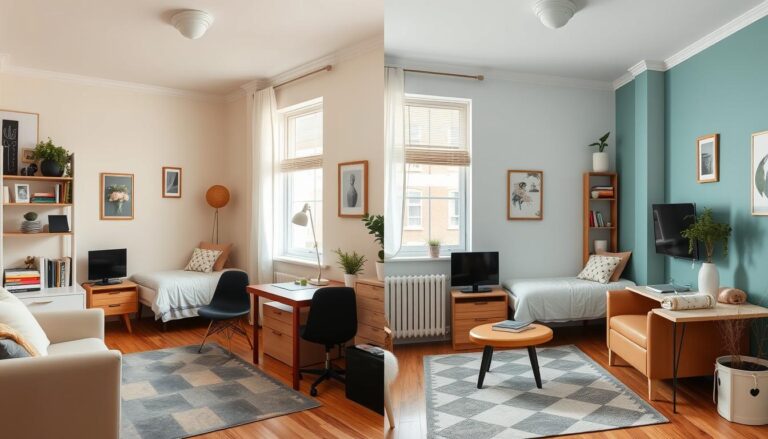How to build a portable laundry station for shared dorm bathrooms
Learn how to simplify college life by building a portable laundry station for shared dorm bathrooms. Follow our step-by-step guide.
College life often means tight quarters and shared facilities. For students dealing with limited room layouts, managing clothes care can become a daily hassle. A customizable mobile unit offers an answer to this common struggle, combining storage and functionality without sacrificing precious square footage.

This project focuses on designing a space-saving setup that holds detergent, baskets, and other essentials in one spot. The rolling base lets you shift your supplies between your study area and communal washing zones effortlessly. With basic tools and materials, you’ll craft a piece that simplifies your routine while adding a touch of personalization to your temporary home.
Key Takeaways
- Maximize small spaces with vertical storage and multi-functional compartments
- Easy-to-move design adapts to dorm rooms or shared washing areas
- Requires only fundamental DIY skills and affordable materials
- Reduces time spent sorting through scattered cleaning products
- Helps create an organized environment that boosts daily productivity
Beyond practical benefits, this solution brings structure to chaotic schedules. By keeping everything from stain removers to fabric softeners within reach, you’ll spend less time prepping loads and more time focusing on what matters. The finished unit becomes both a utility hub and a subtle way to make institutional housing feel more inviting.
Introduction and Benefits of a Portable Laundry Station
Managing daily tasks in campus accommodations can test any student’s patience. Limited storage and crowded washing areas turn simple chores into time-consuming puzzles. A compact organizational hub solves these issues by combining smart design with easy mobility.

Why Campus Life Demands Better Solutions
Traditional laundry methods in student housing often lead to misplaced products or overflowing baskets. A structured approach keeps essentials sorted and accessible. One user noted: “When everything has its spot, you stop dreading wash day.”
| Traditional Approach | Mobile Unit Benefits |
|---|---|
| Scattered cleaning supplies | Dedicated shelves for detergent & stain remover |
| Multiple trips to facilities | Rolling design transports full loads |
| Mixed clean/dirty items | Separate compartments for different cycles |
Transforming Daily Routines
The right setup cuts sorting time by half while preventing lost socks or spilled softener pods. Vertical storage maximizes tight spaces – perfect for fitting between desks or beds. Students report finishing laundry jobs 40% faster with this method.
What Else Would You Like to Know?
Choose below:
Beyond practicality, maintaining order creates psychological benefits. Spaces that function efficiently naturally feel more welcoming. When your basics are handled, you gain mental bandwidth for studies and social activities.
Materials, Supplies, and Preparations
Smart preparation separates successful DIY projects from frustrating ones. Before diving into construction, gather these carefully selected components to create a unit that handles weekly loads with ease.
Essential Building Materials and Tools
Start with a 4×8-foot sheet of ¾-inch plywood – most hardware stores will cut it to 15½-inch widths for precise sizing. Pair this with 1×2-inch pine boards for shelf supports and ¼-inch plywood for the back panel. The caster combination (2 swivel with brakes, 2 rigid) ensures smooth navigation through tight spaces.
Wood screws, deck screws, and waterproof glue form the foundation for sturdy joints. Don’t forget finishing touches: primer protects against moisture, while shelf liner adds grip for detergent bottles.
Reviewing the Supply List and Measurements
Dimensions matter most when coordinating with standard 1.25-bushel baskets. The bottom panel measures 15½x26 inches, while side pieces stretch to 36 inches tall. Three pine rails at 10″, 21″, and 32″ heights create organized zones for sorting.
One student shared: “Getting the cuts done at the store saved me hours and guaranteed my shelves fit perfectly.” Always double-check shoe molding lengths (27½” and 15½”) before angled cuts – these frame the top neatly.
Pre-drill holes to prevent splitting, especially near edges. This attention to detail during setup prevents wobbles and extends your unit’s lifespan through countless cycles.
Step-by-Step Guide to building a portable laundry station for shared dorm bathrooms
Crafting functional furniture for compact spaces requires precision and smart planning. Follow these straightforward phases to assemble a durable organizer that simplifies your weekly routine.
Cutting and Preparing Plywood and Pine Boards
Start by sanding all wood pieces to prevent splinters. Align the 26-inch bottom panel with side pieces using waterproof glue. Pre-drill holes at 6-inch intervals before securing with deck screws – this prevents splitting and ensures flush surfaces.
Assembling the Box Structure and Attaching the Back
Clamp the top piece (27½ inches wide) to complete the frame. Apply putty to screw heads once the glue dries. Attach the ¼-inch back panel using ¾-inch screws, creating a rigid structure that withstands daily use.
Installing Rails, Wheels, and Final Touches
Mount pine rails at measured heights using clamps during glue curing. One user shared: “The adjustable shelves changed how I sort lights and darks.” Add casters 1 inch from corners for smooth mobility. Finish with trim and non-slip liner secured by staples.
Allow 24 hours for paint to cure before loading baskets. The 26-inch interior fits standard baskets perfectly, while the sturdy wheels handle transitions from room to shared facilities effortlessly. Regular maintenance keeps your unit looking new through years of service.
Additional Tips for Dorm Laundry Organization and Maintenance
Keeping your clothes care system efficient requires smart habits beyond initial setup. These strategies help maintain order while adapting to evolving needs throughout the semester.
Optimizing Space and Storage Solutions
Collapsible mesh baskets save room when empty. Mount adhesive hooks on vertical surfaces for lint rollers or stain treatment pens. Label shelves to separate clean towels from gym wear.
Portable washing machines – ideal for compact living – should sit on waterproof mats. Store detergent pods in stackable jars to prevent moisture damage. One user noted: “Grouping supplies by laundry day steps cut my prep time in half.”
Maintenance, Cleaning, and Upkeep Tips
Wipe down surfaces weekly to avoid detergent residue buildup. Check caster wheels monthly for hair or debris that affects mobility. Air out damp items immediately after dryer cycles.
Rotate seasonal clothing to the top shelf for easy access. Use baking soda in empty compartments to neutralize odors. These small actions preserve your system’s functionality while keeping your home-away-from-home fresh.
FAQ
What materials work best for a compact dorm laundry setup?
How can I maximize space in small shared bathrooms?
What maintenance keeps the unit functional long-term?
Can this system handle heavy loads without tipping?
How do I personalize it to feel homier?
What’s the average setup time for beginners?
The Best Colors to Make Your Student Apartment Feel Bigger
» See exclusive tips for your home








